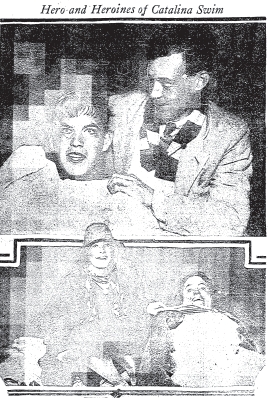
William Wrigley’s Ocean Marathon



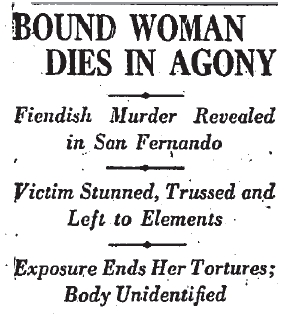 The body of an unidentified woman was discovered off of Mulholland St. (now called Foothill Blvd.) in San Fernando today.
The body of an unidentified woman was discovered off of Mulholland St. (now called Foothill Blvd.) in San Fernando today.
Her hands were bound across her chest with twine. Her knees were bent, and her feet tied to her back with a length of cord. Her body had been wrapped in canvas. She had been struck in the forehead with a blunt instrument; however, a preliminary autopsy revealed that the blow was not hard enough to have killed her. Most likely, she was knocked unconscious by her assailant, tied up, then left to die of exposure.
The dead woman was approximately 45 years of age, and was found wearing a black crepe dress, "cheap cotton underwear," and hose. Her shoes had been removed. She had false upper teeth and a scar. She had been drinking the night she was beaten and left to die. She had been dead for approximately 24 hours before she was found, and lay in the San Fernando morgue for four days until she was identified as Amelia Appleby of 229 N. Hobart Blvd.
The fourth wife of a wealthy Chicago inventor, Appleby had inherited a $1 million estate upon his death, taken the money, and moved to California. She was not well-liked by her late husband’s family, nor by her Los Angeles neighbors, who described her as "eccentric" and "a troublemaker." However, she did have one friend who cared enough to tell police what she knew. Prior to her death, Appleby was known to keep company with a "doctor" named Charles McMillan, 57. Appleby had confided to her friend that she feared McMillan would kill her if she refused to marry him.
McMillan was rounded up at his 531 S. Western Ave. apartment, where police found him poring over a stack of Appleby’s personal papers. They later found more of her personal items, including her diamond jewelry, in McMillan’s possession. Police investigators later found two versions of Appleby’s will, one which left her estate to McMillan, and another which left it to a long-lost daughter, although her relatives claimed that she’d never had a child. Neither will was signed, and both were strongly suspected to be forgeries.
The evidence against McMillan was circumstantial, but strong. The stolen papers and jewels, a blood-stained jacket, the forged will, and the fact that he was the last person to be seen with Appleby were enough to convince jurors of his guilt. McMillan was convicted of murder and sentenced to life in prison on February 24, 1928.
 Superintendent of Schools Susan Dorsey spoke out on behalf of Mary Holt, registrar at the Mt. Vernon Junior High, saying, "I spoke with Mrs Holt, and am satisfied that I would have acted as she did if I were confronted with the same circumstances."
Superintendent of Schools Susan Dorsey spoke out on behalf of Mary Holt, registrar at the Mt. Vernon Junior High, saying, "I spoke with Mrs Holt, and am satisfied that I would have acted as she did if I were confronted with the same circumstances."
Holt excused Marion Parker from school on Thursday, December 15 when a slender man came to the desk and asked for "P.M. Parker’s youngest daughter," saying that her father had been in an automobile accident. Holt hesitated, knowing that Marion was a twin. However, the man persisted, saying, "I am an employee at the bank where Mr. Parker is chief clerk, and if there is any doubt in your mind, here is the bank’s telephone number. You may call there."
Convinced, Holt sent an office assistant to get Marian from class. "Marion was nervous and excited when I told her that her father had been injured. The news completely broke up a little Christmas party the children were having in their room, and Marion had some of the refreshments in her hands when she came into the room. But at once she forgot about everything but her father."
Marion was excused from school, and left with the man who would, three days later, end her life.
After the kidnapping, Holt said, "Oh, I can think of many things I could have done now. I never would have let Marion go but for the apparent sincerity and disarming manner of the man."
Private funeral services for 12-year-old Marion Parker were held today at the Little Church of Flowers at Forest Lawn Cemetery, after which her body was cremated. The search for her killer continues, with police and citizens as far away as Denver and Portland on the lookout for the Fox.
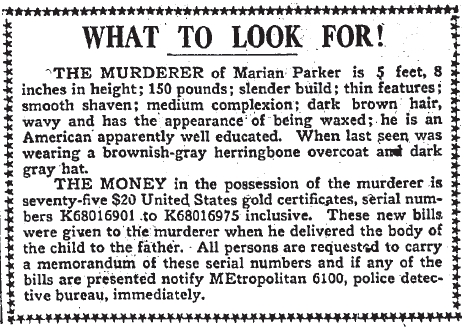
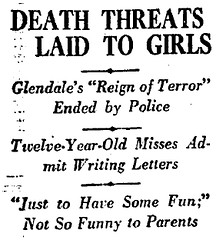 Three Glendale families found interesting missives in their mailboxes this week, and they weren’t no holiday wishes.
Three Glendale families found interesting missives in their mailboxes this week, and they weren’t no holiday wishes.
The Van Pelt family received a note reading: "You are to be killed tonight at 10pm sharp."
The Westons were warned, "Highway bandits will rob your house tonight."
And then, the cryptic letter received by the Simingtons: "Beware of the goat. He is watching you."
Today, Glendale police revealed that two bored 12-year-old girls named Dorothy Alman and May White were responsible for the threats which kept the neighborhood "on the verge of nervous spasms for several days."
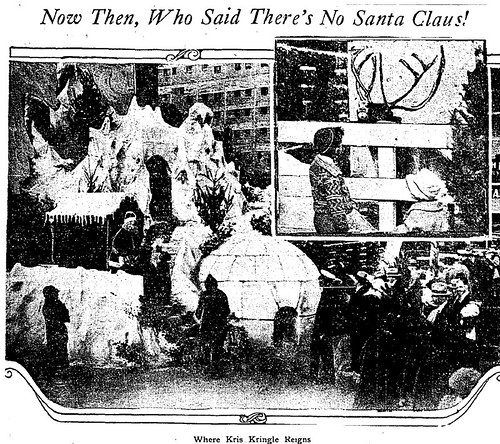
December 5, 1927
 Mr. and Mrs. Jack Laughlin of 2115 S. Harvard departed for a weekend getaway in San Diego, leaving their daughter, June Blossom, 14, in the care of their housekeeper and family friends. After saying goodbye to her folks, June invited her friend Mary Jane Carroll, 13, over for the weekend.
Mr. and Mrs. Jack Laughlin of 2115 S. Harvard departed for a weekend getaway in San Diego, leaving their daughter, June Blossom, 14, in the care of their housekeeper and family friends. After saying goodbye to her folks, June invited her friend Mary Jane Carroll, 13, over for the weekend.
Sunday afternoon, the girls went outside to play, and vanished. Shortly after their disappearance was noticed, the blue dress and sandals that June had been wearing that day were found in a nearby vacant lot. When the Laughlins returned, they found that in addition to a missing daughter, about $4000 worth of clothing and tapestries were missing from their home.
So sinister-sounding were the facts surrounding the disappearance of Mary Jane, and June that it seems impossible that the incident wrapped up as happily as it did. As it turns out that the whole thing could be chalked up to a case of "girls will be girls."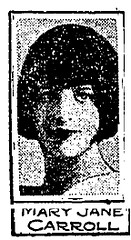
On December 6, Mr. Laughlin and Mr. Carroll set out to pick up their daughters from a San Diego hotel. The girls had skipped town on a lark with the intention of surprising June’s parents in San Diego. Unfortunately, they’d left around the same time that Mr. and Mrs. Laughlin had started home.
No word on how June’s clothes turned up in the lot, or the whereabouts of the missing tapestries; however, the most precious cargo was accounted for, albeit in deep, deep trouble.
 Some minor cuts scrapes for Clara Bow today, but that’s what happens when you take on the USC football team.
Some minor cuts scrapes for Clara Bow today, but that’s what happens when you take on the USC football team.
Ms. Bow hosted a garden party, to which she invited a few members of the victorious Trojans. The glamorous hostess revealed herself to be an avid fan of the sport, and asked quarterback and future College Football Hall of Famer Morley Drury how the team managed "those end-around plays." The Trojans were only too happy to demonstrate on the lawn. Caught up in the spirit of things, Ms. Bow drew too close to the "Thundering Herd," and was pommelled to the ground. Fortunately, she suffered only a bruised thumb.
 And what started as a few pesky mosquito bites turned into a near-miss disfiguring for Dolores Del Rio. While vacationing in Soboba Springs, Ms. Del Rio treated the bites with an acid-based ointment. Today, she was treated by a physician for burns and "skin poisoning."
And what started as a few pesky mosquito bites turned into a near-miss disfiguring for Dolores Del Rio. While vacationing in Soboba Springs, Ms. Del Rio treated the bites with an acid-based ointment. Today, she was treated by a physician for burns and "skin poisoning."

When Ora’s mother died in 1920, the girl was left in the custody of Obetz, who spent the next few years traveling around the Ozarks in a wagon with her. When she turned 13, he gave her the choice of being placed in juvenile home, a convent, or becoming his wife. After a month of convent living, Ora finally consented to marry him in Kansas.
A year later, Ora gave birth to a son, and the Obetzs moved to Los Angeles. Shortly thereafter, Louis threatened Ora at gunpoint, at which point, the brave girl picked up her infant son, marched out the door, and left Obetz for good. That was two years ago.
Since then, Obetz filed a $100,000 "alienation of affection" suit against 83-year-old A.F. Christianson, a wealthy Angeleno whom Obetz claimed had influenced Ora’s decision to leave him. But before that case was heard, Ora had her day in Superior Court. The issue at hand was not whether Ora was coerced into marriage, due to the fact that Kansas had no laws mandating the age at which girls could marry. However, the legality of the marriage was called into question by Ora’s testimony that a friend of Obetz’s had posed as her dead father in order to obtain the marriage license.
On December 7, 1927, Obetz’s suit against Christianson was dismissed when the former failed to appear in court. He didn’t show his face on the 9th either, when Ora Obetz was granted her annulment and full custody of her son.
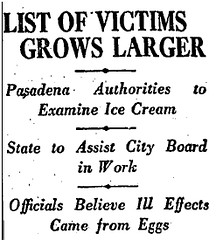 Over 100 Pasadena residents are clutching their guts today, the victims of a recent outbreak of food poisoning. Those affected had all eaten a batch of tainted French vanilla ice cream sold by a local catering company. At first, the toxins were suspected to have come from the copper mixing vats used by the unnamed company; however, after questioning some of its employees, City Bacteriologist C.W. Arthur and City Chemist Frank Marks (how ’bout those job titles!) uncovered the true culprit.
Over 100 Pasadena residents are clutching their guts today, the victims of a recent outbreak of food poisoning. Those affected had all eaten a batch of tainted French vanilla ice cream sold by a local catering company. At first, the toxins were suspected to have come from the copper mixing vats used by the unnamed company; however, after questioning some of its employees, City Bacteriologist C.W. Arthur and City Chemist Frank Marks (how ’bout those job titles!) uncovered the true culprit.
It seems that the ice cream recipe called for an egg mixture which the company only bothered to make about once a week. Unfortunately, the ice cream was frequently made several days later. Arthur and Marks found that a scoop of the toxic French vanilla contained about 20 times as much bacteria as a sample of raw sewage.
Oh, careless confectioner, what have you wrought!